My collecting story… M.M. in Freeport, NY…
January 25, 2021 by GuyHeilenman · Leave a Comment
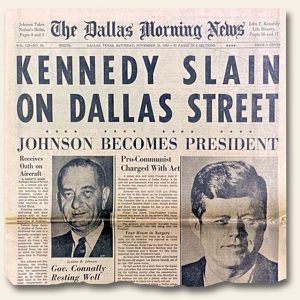
Below we continue our series in which we post the “stories” graciously submitted by our collecting friends during the pandemic of 2020-2021.
I have always loved history from as far back as the 8th grade. My teacher started teaching us about Abraham Lincoln [during our unit on] the Civil War. Then one day I went to a garage sale [in upstate New York] with my brother. He knew I loved history, and he found an old school house picture of George Washington. So, I started reading about George Washington. Finally one day my friend called me and told me that he had a gift for me. When I got there he give me my gift – a November 23, 1963 New York Times. I couldn’t believe I was holding a newspaper older than me – and especially a newspaper on the assassination of JFK. From that point on I have never stopped buying [historic] newspapers. Thank you Rare & Early Newspapers for helping me have great collection of newspapers.
As additional “stories” are posted they will be available at: MY COLLECTING STORY. We did this many years ago as well – and their posts are also included.
My Collecting Story… G.F. in Lexington, Virginia…
December 3, 2020 by GuyHeilenman · Leave a Comment

Continued below in the next installment in our series in which we post the “stories” graciously submitted by our collecting friends during the pandemic which began in 2020.
I love US history and as soon as I earned a permanent salary, I started visiting historical sites and eventually turned to collecting items of interest, particularly US Civil War. I collected many of my Harper’s from numerous civil war shows; my favorite is a Richmond Examiner, 23 June 1864 (long before I knew about the RareNewspapers.com website); it talked of Sherman’s campaign and how it would end like Napoleon’s in Russia! Great reading. Years went by and I am a docent at the Stonewall Jackson House in Lexington, VA (come by when this contagion is past and we’re open again). I prepared a presentation on Jackson in the Mexican War; I came across your site and ordered a “National Intelligencer,” 16 Nov 1847 and “The Union,” also dated 1847. Future Civil War luminaries their exploits abound. Finally, and not about the Civil War, my wife loves to explore Scottish roots and your site had several papers regarding the Scottish rebellion of 1746, referencing the battle of Culloden – yep, I bought it as a Christmas gift for her. Your site piques my curiosity and I’ll remain a customer!
As additional “stories” are posted they will be available at: MY COLLECTING STORY. We did this many years ago as well – and their posts are also included.
Harper’s Monthly & The Self-Made Man – Still Learning…
October 12, 2020 by Stephanie Williams · Leave a Comment
By natural inclination, I spend a fair amount of my spare time delving into the “women’s publications” within the Rare & Early Newspapers collection. Consequently, the title of the Editor’s Table of an 19th century issue of Harper’s New Monthly dragged me in, and in the spirit of fair play I decided to dissect and disseminate the contents, using the writer’s three questions.
Who is the Self-Made Man? In the author’s view, this is not the man who achieved much because of education, as education is an outside influence that detracts credit from the man. However, a self-made man can be educated. The one who is not educated, but rises to success in spite of the lack, is not necessarily self-made, as success does not equal the morality required in a self-made man.
What is the Self-Made Man? Again, this is not the one who commits good deeds, although a self-made man will be characterized by them. “The difference between the two characters is a moral one. It springs from the presence or absence of the humanitarian spirit. It is all the difference between the pure love of truth and the love of opinion.”
What is his true position for good or for evil among the powers of the age? Finally, all the negatives are set aside and the author clearly promotes a man who is driven to find truth — not in new discoveries or insights, but in the wisdom of the ages that has been tested by time, and continues to be trustworthy. Ultimately, the author highly esteems the members of the Protestant Reformation, and the things they accomplished. “It was an age where old truths were brought to light and re-established as old truths. It was a most serious age; it was a modest age; and in all these respects, especially in the latter, it differed widely from our own.”
The final condemnation of the modern era, male and female, is contained in the author’s closing remarks:
All the writings of every kind during that remarkable period, and, we may even say, the century that followed it, would not present so much of this frothy self-laudation, as may be heard in one Hope Chapel meeting of ‘strong-minded women’ and ‘self made’ men.
My collecting story… P.S. from City of Industry, CA…
October 8, 2020 by GuyHeilenman · Leave a Comment
Below we continue our series in which we post the “stories” graciously submitted by our collecting friends during the pandemic of 2020.
The Workman and Temple Family Homestead Museum in the City of Industry, California, east of Los Angeles, interprets the region’s history from 1830 to 1930 and, among the approximately 30,000 artifacts in the artifact collection are hundreds of historic newspapers, most dating to the 1870s, a key time period in our interpretation. Among the more unusual of the papers is the first of twelve issues of the “Willow Dale Press,” an amateur paper published by 13-year old Florence Carter and her 10-year brother, Arthur, children of rancher and developer Nathaniel Carter. The family migrated in 1874 from Lowell, Massachusetts to the San Gabriel Valley east of Los Angeles for a reason many others did: health. Nathaniel Carter suffered from serious pulmonary issues and the temperate climate of the valley proved to be a balm for his ailments. The Carters, who bought their 17-acre spread from George Stoneman, a Union Army general during the Civil War and future California governor, and christened it “Willow Dale.” Widely known for its picturesque location, fine home, and its landscaping, Willow Dale was photographed by Carleton Watkins, famed for his images of Yosemite. The site is in today’s city of San Marino, very near the Huntington Library, Art Galleries and Botanical Gardens.
The Carter siblings were provided with a small foot-treadle operated press with a self-inking action made in Boston and which produced a dual-column sheet measuring 6 inches by 9 inches. The duo’s sheet was among many so-called “juvenile papers” published throughout the nation as literacy rates skyrocketed. This first issue, for January 1879, appeared late the following month, as one of the major dailies in Los Angeles, the Herald, noted in its Christmas 1878 edition that “we are indebted to our editorial confreres of the Willow Dale Press for a handsome chromo of the ‘Village Mill’,” this chromolithograph produced on their press being a free gift with a subscription, a savvy marketing tool for the young entrepreneurs, who were appealing “to our young friends” in making their “editorial bow.”
In fact, Florence and Arthur felt compelled to state “one of us has hardly reached, while the other has just entered our teens, and so our readers as they look over the paper will please pass judgment accordingly.” They intended “to present each month, a good selection of reading matter, with articles which will be written expressly for this paper.” They also added that “we will be glad to receive communications from any of the young folks, also charades, enigmas or conundrums which are original.” Moreover, the Carters expressed a willingness to exchange with other like publications and made the offer to “each month present for THE OLD FOLKS a column which we hope they will find interesting and profitable, as we find it the most profitable to us.” Another promotion was that a person who secured the most subscribers would get 500 cards with more than 200 types to choose from and room for up to three names, while the second and third highest producers would receive 300 and 100 cards, respectively. Elsewhere, the pair advertised for the “latest styles” in New Year’s presentation cards.
Humor, or the attempt at, proved to take up much of the space in the issue, including this example: a small store about ten feet by twelve in East Los Angeles [a neighborhood now known as Lincoln Heights] has three large signs—MARKET—upon it, which nearly cover the building. Florence said we rode along, she did not think they need “Mark-It” any more. Another bit of humor was reprinted from the popular Youth’s Companion, and told of a woman who got chills from sitting on a rock until she learned that it was a block of ice covered with carpets to delay its melting. For the “Old Folks Column,’ that consisted of an ad for a local doctor, a nearby nursery, and for the well-known resort, the Sierra Madre Villa, which was north of the Carter’s place.
Though the paper moved up in summer to a larger size of 9 ¼ x 7 ¼ with three columns and a new masthead with an increase in the subscription rate to 25 cents per year, at which time the Herald acknowledged receipt of the sixth issue and called the Press “a spicy, readable sheet,” the Carters only kept the journalistic endeavor going to the end of 1879. Two issues were produced by their father because Florence and Arthur took a long trip to see their maternal grandmother in Northern California. When the paper folded, the  explanation was that the closure was due to “school work, baseball and archery,” these being childhood concerns that made eminent sense for the practical business decision reached by the young proprietors.
explanation was that the closure was due to “school work, baseball and archery,” these being childhood concerns that made eminent sense for the practical business decision reached by the young proprietors.
Just after the shuttering of the paper, the Carters moved to a new 103-acre tract known as “Carterhia,” while Nathaniel developed another 1000 acres and developed the town of Sierra Madre at the base of the chain of mountains once known by that name and later changed to the San Gabriel range. Florence later married a prominent Y.M.C.A. official in Los Angeles and raised a family. After she was widowed, she worked as a librarian and a Christian Science practitioner. Arthur, who remained at Sierra Madre, became a ranger in the newly created national forest in the mountains above the town and ran the Carter’s Camp resort in Big Santa Anita Canyon above Sierra Madre. Later, he was an orange grower in town, where he and his wife raised their family.
So, while the Willow Dale Press was short-lived, it was significant in that it was the first amateur or juvenile paper in greater Los Angeles and, in fact, was the first paper at all in the western San Gabriel Valley, as even the new town of Pasadena did not have one until the early 1880s.
As additional “stories” are posted they will be available at: MY COLLECTING STORY. We did this many years ago as well – and their posts are also included.
My collecting story… B. C. in Trion, Georgia..
October 5, 2020 by GuyHeilenman · Leave a Comment
Below we continue our series in which we post the “stories” graciously submitted by our collecting friends during the pandemic of 2020.
I am the published author of over a dozen books of fiction and nonfiction. A few years ago, my publisher suggested that I write a book about Kathryn Kelly, the wife of “Machine Gun” Kelly and also the “brains” behind the crimes they committed over several years. What little I could find about K athryn was interesting, but since no other books had ever been written about her, research was difficult. I turned to the FBI Vault of historical documents and personally interviewed people who lived during the Great Depression and the “Gangsta” Era. And then I came across “Timothy Hughes: Rare & Early Newspapers.” It was like finding a gold mine. I was able to access the newspapers from that time period that followed the crimes and eventual arrest of Kathryn Kelly and Machine Gun Kelly. With this information, along with the other research I had gathered, I wrote the book, Kathryn Kelly: The Moll behind Machine Gun Kelly. It was recently optioned for a major film. The newspaper I have saved for my collection is “The Bethlehem Globe-Times” – Tuesday, September 26, 1933. On the front page is the headline: “Machine Gun” George Kelly Is Captured. The sub-headline reads: Desperado Surrenders Without Resistance – Wife Is Also Taken Into Custody.
athryn was interesting, but since no other books had ever been written about her, research was difficult. I turned to the FBI Vault of historical documents and personally interviewed people who lived during the Great Depression and the “Gangsta” Era. And then I came across “Timothy Hughes: Rare & Early Newspapers.” It was like finding a gold mine. I was able to access the newspapers from that time period that followed the crimes and eventual arrest of Kathryn Kelly and Machine Gun Kelly. With this information, along with the other research I had gathered, I wrote the book, Kathryn Kelly: The Moll behind Machine Gun Kelly. It was recently optioned for a major film. The newspaper I have saved for my collection is “The Bethlehem Globe-Times” – Tuesday, September 26, 1933. On the front page is the headline: “Machine Gun” George Kelly Is Captured. The sub-headline reads: Desperado Surrenders Without Resistance – Wife Is Also Taken Into Custody.
As additional “stories” are posted they will be available at: MY COLLECTING STORY. We did this many years ago as well – and their posts are also included.
My collecting story… L.H. in Williamsport, PA…
July 23, 2020 by GuyHeilenman · Leave a Comment
Below we continue our series in which we post the “stories” graciously submitted by our collecting friends during the pandemic of 2020.
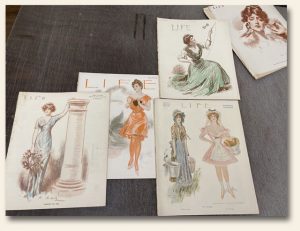 (to unfamiliar surroundings) for me soon became so much more! Over the years each of our children have worked at the “History’s Newsstand” and have developed a deep appreciation of history and all it’s lessons.
(to unfamiliar surroundings) for me soon became so much more! Over the years each of our children have worked at the “History’s Newsstand” and have developed a deep appreciation of history and all it’s lessons.
As additional “stories” are posted they will be available at: MY COLLECTING STORY. We did this many years ago as well – and their posts are also included.
My collecting story… J. W. in Stow, MA…
July 20, 2020 by GuyHeilenman · Leave a Comment
Below we continue our series in which we post the “stories” graciously submitted by our collecting friends during the pandemic of 2020.
Why do I collect rare/historic newspapers? How did I get started?
In 2004, shortly after the Boston Red Sox won World Series, I received a January 7, 1920 copy of the New York Times as a gift from my wife. After not seeing any significant headlines in the paper, my wife 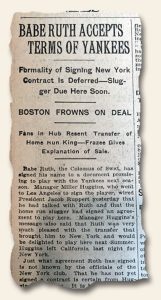 said, “Check out the sports page”. There on page 22 was the trade of Babe Ruth to the New York Yankees, the legendary “Curse of the Bambino”. This inspired my interest to assemble a collection that epitomizes what it meant to be a true Red Sox fan including the 1918 World Series victory (Christian Science Monitor dated September 12, 1918), the aforementioned sale the legendary slugger to the Yankees, the subsequent 86 years of agony including the ’46, ’67, ’75, and ’86 World Series defeats, and finally the breaking of “the curse” by beating the Yankees and Cardinals to win the World Series that I had just secured in my October 2004 copies of the Boston Globe.
said, “Check out the sports page”. There on page 22 was the trade of Babe Ruth to the New York Yankees, the legendary “Curse of the Bambino”. This inspired my interest to assemble a collection that epitomizes what it meant to be a true Red Sox fan including the 1918 World Series victory (Christian Science Monitor dated September 12, 1918), the aforementioned sale the legendary slugger to the Yankees, the subsequent 86 years of agony including the ’46, ’67, ’75, and ’86 World Series defeats, and finally the breaking of “the curse” by beating the Yankees and Cardinals to win the World Series that I had just secured in my October 2004 copies of the Boston Globe.
During my efforts to find these papers at Rarenewspapers.com and on eBay, I found a 1791 copy of the Middlesex Gazette, Middletown, CT announcing that Vermont has become the 14th state of the union and the FIRST to enter under the terms of the new federal Constitution. My wife 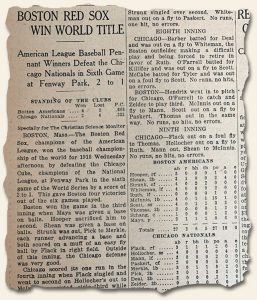 and I were married in Vermont (where her parents lived for 35 years and where her ancestry has been traced to one of Ethan Allen’s brothers and the “Green Mountain Boys”) so it was of some personal interest as well. For only $30, I thought this paper was amazing and my wife suggested that I try to collect papers announcing statehood for each of our 50 states. With the prospect of searching for another 49 papers seeming a bit overzealous, I decided instead to focus on finding papers announcing statehood of the original 13 colonies.
and I were married in Vermont (where her parents lived for 35 years and where her ancestry has been traced to one of Ethan Allen’s brothers and the “Green Mountain Boys”) so it was of some personal interest as well. For only $30, I thought this paper was amazing and my wife suggested that I try to collect papers announcing statehood for each of our 50 states. With the prospect of searching for another 49 papers seeming a bit overzealous, I decided instead to focus on finding papers announcing statehood of the original 13 colonies.
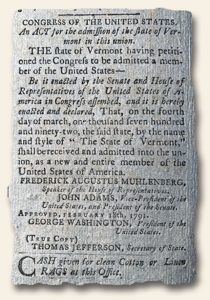 It took a couple of years to secure all these statehood ratification newspapers and in the process, I found a paper with Maine becoming a state in 1820. Although this was beyond the scope of my original search, I remembered that Maine’s statehood was a part of the Missouri Compromise. So certainly, I had to search for a Missouri statehood paper! This was what is equivalent to today’s Google searches are on so many levels … one piece of history leads to another to another to another! And with this, my affinity for newspaper collecting had begun.
It took a couple of years to secure all these statehood ratification newspapers and in the process, I found a paper with Maine becoming a state in 1820. Although this was beyond the scope of my original search, I remembered that Maine’s statehood was a part of the Missouri Compromise. So certainly, I had to search for a Missouri statehood paper! This was what is equivalent to today’s Google searches are on so many levels … one piece of history leads to another to another to another! And with this, my affinity for newspaper collecting had begun.
At the same time, by reading books such as David McCullough’s “1776 “and “John Adams”, “The Founding Brothers” by Joseph Ellis, and James Madison’s notes on the Constitutional Convention, my interest in U.S. history was further awakened and my interest began to shift to 18th and 19th century papers. These papers provide primary source documentation described in rich and colorful language that is not experienced in academic settings. As my appreciation of the hobby grew, I began to assemble groups of papers that are linked together by a particular event or series of events that “tell the story” in real time by those who were living at the time. It is with this mindset and approach that I have continued to be an avid collector to this day.
As additional “stories” are posted they will be available at: MY COLLECTING STORY. We did this many years ago as well – and their posts are also included.
My collecting story… T. S. P. in New York, NY…
June 12, 2020 by GuyHeilenman · Leave a Comment
Below we continue our series in which we post the “stories” graciously submitted by our collecting friends during the pandemic of 2020.
When we were kids my dad gave my older brother Some old paper money preserved between pieces of glass from colonial days and an old facsimile copy of a newspaper from the day that Lincoln was shot. It made a big impression on me. So when I started collecting old newspapers for the book it was that newspaper that inspired me to start a collection of my own. I remember how I felt when I picked it up and looked at it and realized that people of the time were reading these words that they were holding this paper and seeing the news for themselves. You could hear them saying how they felt about what was going on. And so not too long ago I made a point of going through your online catalog looking for some of these old Lincoln newspapers. I spent hours and days pouring over these and picking out from all those that were published on that day. I look for papers that were poignant or well illustrated or published in towns near where earlier generations of my family had lived. I looked for illustrations that showed the American spirit the way people felt at time and the events of the day. I wanted to find the illustration of John Wilkes Booth leaping to the stage from Lincoln Sparks at Ford theater. I wanted to show him laying in state. I wanted to show the crowds lining the railroad tracks as his train with his coffin Road by. I wanted to show those allegorical illustrations that show the country in the morning. But most of all, I wanted to show future generations of my family a paper that might’ve been the one that our own ancestors would’ve read that day. I was collecting all of this to make a record of the world that my family had lived in here in North America since 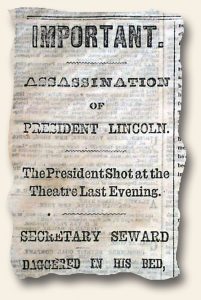 the early 1600s. I wanted to future generations to know the story of what it took to build the life we now enjoy. I wanted them to see the uncertainties We faced, the tasks that were set for us as events as unfolded And the choices we made.
the early 1600s. I wanted to future generations to know the story of what it took to build the life we now enjoy. I wanted them to see the uncertainties We faced, the tasks that were set for us as events as unfolded And the choices we made.
The other day I was watching some old movies in honor of Easter and Passover and among them was the 10 Commandments. At the end of the movie Moses is told by God that he is not going to be crossing the river Jordan. He was not going on with the people here the lead to the new land. The story of Lincoln‘s death is much the same. He had brought us through the Civil War and set down for all time on a document that ended slavery and freed a people. And then when peace was only moments away, he died and did not cross over into that time with the rest of us. I’m trying to remember at the moment whether or not FDR died before peace was declared at the end of World War II. He had brought us through the great depression, the dust bowl and World War II. And then there’s Martin Luther King and his “ I have a dream “ speech that was so prophetic. None of these men crossed over into the peace that they saw coming and into the land that they had envisioned and fought for — but they saw it on the horizon.
And so I am going on collecting these papers. I’m showing that events are not as simple as they are written in the history books we read in school. I’m showing the dialogue in the arguments that went on before decisions were made. I’m trying to show that not all people took the same side and then each had their own arguments and their own point of view. They chose their own paths and fought for them. And now when my family closes the book I plan to leave for them to read I want them to choose for themselves a path that will take him into the future. They may not cross over into the future is that they plan but I want them to think about the course and make a choice.
As additional “stories” are posted they will be available at: MY COLLECTING STORY. We did this many years ago as well – and their posts are also included.
Still Learning… Harper’s Monthly Magazine & Disaster…
June 8, 2020 by Stephanie Williams · Leave a Comment
These past few months have been characterized by intense focus. I wonder if we are all concentrating fiercely on the task at hand, since everything else seems a bit too immense. Whatever the reason, I have thoroughly immersed myself in systematically working through volumes of titles in search of particular dates of interest as if this is the most important job in the world. Since publications in view are from the 1800’s, I am glimpsing snippets of similarities and of differences to our modern era.
 While shelving Harper’s New Monthly Magazine, I read the following:
While shelving Harper’s New Monthly Magazine, I read the following:
“Harper’s Magazine has now reached the close of its Tenth Volume. During the five years of its existence, its prosperity has been constant and uninterrupted. It has not been checked even by the disaster which fell upon the establishment of the Publishers, or by the period of general depression from which the country is now emerging.”
I didn’t know about this time of economic difficulty that Wikipedia describes as “lasting [from the Great Panic of 1837] until the Great Panic of 1857.” From where we stand it is easy to lose a historical perspective, but the December 1854 issue — sandwiched between two economic trials — provides that opportunity. The editor’s note at the front claims the magazine even flourished through the difficulties. At 144 pages, with 64 illustrations, this Harper’s devotes the first two-thirds to literary offerings ranging from an account of Napoleon’s exile to an installment of fiction by William Makepiece Thackeray. Following that are an extensive listing entitled “Monthly Record of Current Events”, three categories of editorials (Editor’s Table, Editor’s Easy Chair, and Editor’s Drawer), two pages of political cartoons, and the illustrated hoops and flounces that comprise those “Fashions for December.” This is a comfortable compilation that seems to provide a wealth of distracting entertainment that was as surely craved then as it is now, situated alongside a factual depiction of the nation and world.
From the current events section I extracted a nugget of reporting that mirrors modern newscasts.
“It may be stated generally, however, in reference to all of them, that partisan divisions have been less rigid than usual — that old party lines have been broken down.”
Somehow, shared disaster still seems to have that unifying effect.
My collecting story… B.D. in Thornhill, Ontario…
June 5, 2020 by GuyHeilenman · Leave a Comment
Below we continue our series in which we post the “stories” graciously submitted by our collecting friends during the pandemic of 2020.
Some years ago, maybe fifteen, I purchased a London Chronicle newspaper from Timothy Hughes newspapers. This was mainly for the fun of having an old newspaper from ‘the old country’. I have purchased quite a few since then and actually got round to reading some for the fascinating items that the contain. One such item concerns the creation of the chronometer by John Harrison in the 1700s. I had seen his chronometers displayed at the observatory in Greenwich, produced by Harrison in response to Queen Anne’s contest offering a huge reward for a successful timepiece but I could not find out for certain if Harrison was ever paid by the British Government.
LONDON CHRONICLE, London, 1765. Volume XVIII from Saturday, November 2 to Tuesday, November 5, 1765. Contains, on page 436, A Copy of the Certificate of the Commissioners of the Longitude … relating to Mr John Harrison’s Time Keeper, authorizing the payment to him of the 7,500 pounds, less the 2,500 already paid out. According to Wiki, Harrison received 8750 pounds in 1773 when he was 80 years of age but the “official award (from year 12 of Queen Anne’s reign) of 7,500 pounds was never given to anyone”. Dava Sobel in her wonderful book Longitude (London, Fourth Estate, 1995) says that Harrison’s son, William, sought the king’s intervention (George III) resulting in a payment to John Harrison of 8,750 pounds in June 1773, noting that ‘this amount nearly totaled the remainder of the prize due to him, but that it was a bounty awarded by the benevolence of Parliament – in spite of the Board of Longitude, instead of from it.’ Elsewhere, I have read that his son received this after his father’s death but I cannot recall in which newspaper (one in my collection, I think). This seems to set my questions to rest. It would appear that he was and he wasn’t, depending on how you look at it! He received the cash but not the ‘prize’.
Making the effort to read the newspapers is extremely rewarding but not without it’s difficulties. Some of the older papers, before 1700 are not so easy, especially those using ‘old English’ but it is very rewarding to plunge into the atmosphere created by ‘on the spot reporting’. Some of the items are quite extensive and take a while to plough through. I recently came across the item shown below:
The Supplement for the Year 1793 (to The Gentleman’s Magazine), London, includes on page 1208 an extract of a letter written by an Officer of the Agamemnon of 64 guns, Captain Horatio Nelson, and dated at Tunis, November 8, 1793 (see below). I have had this item for several years and only just spent some time (during this pandemic) reading it properly. I have hundreds yet to scrutinize! Perhaps I will find something that leads to a great historical revelation, or perhaps I will just enjoy reading about history from the pens of people who lived that history!
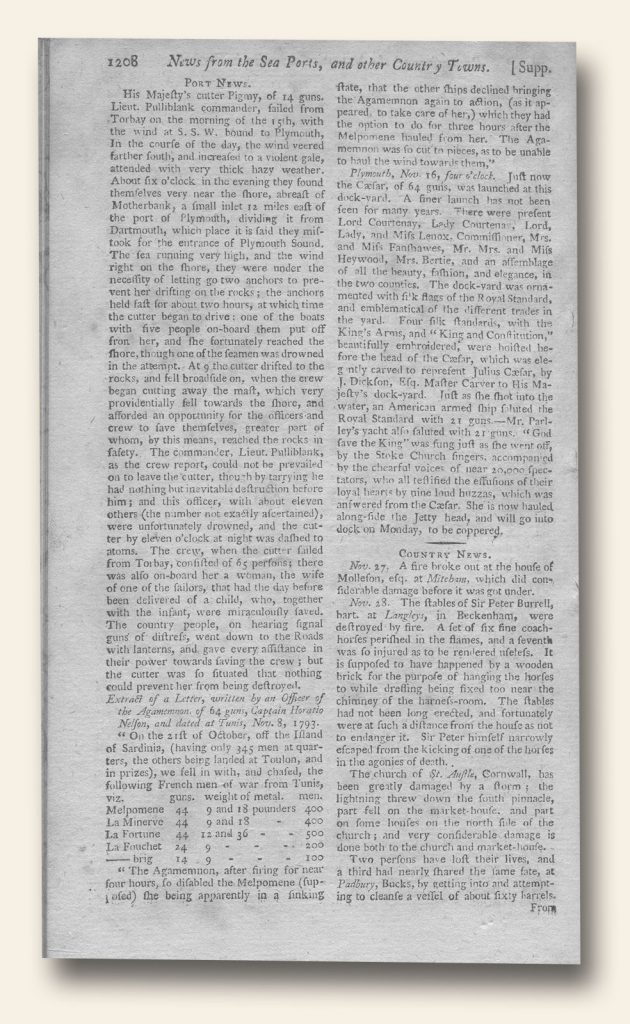
As additional “stories” are posted they will be available at: MY COLLECTING STORY. We did this many years ago as well – and their posts are also included.


